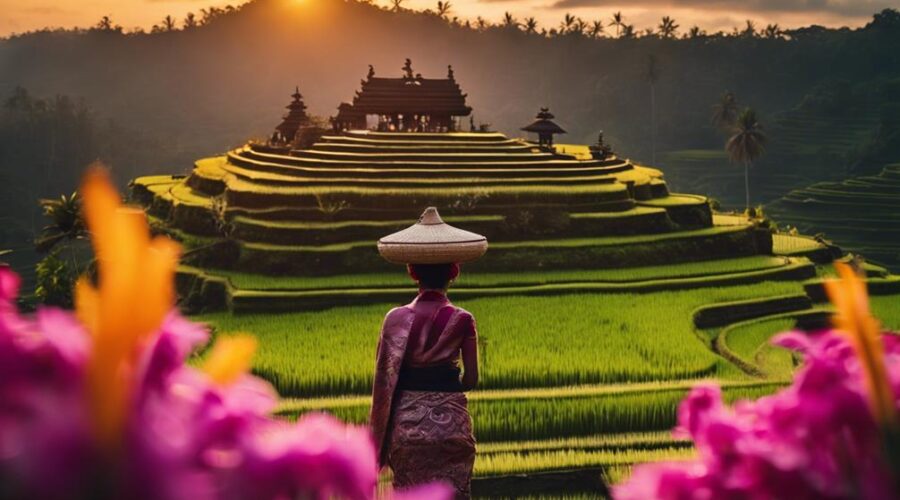What Is Sacred in Bali?
From the serene beaches to the majestic temples, from the sacred springs to the holy mountains; Bali is a land that's saturated with spirituality and sacredness.
You've seen its mesmerizing beauty, but have you ever contemplated the depth of its sacred elements?
Let's explore the meaning and significance of these elements, disclosing the mystery of what is truly considered sacred in Bali.
Are you ready to set off on this enlightening journey of discovery?
Key Takeaways
- Balinese spirituality deeply values harmony, nature, and interconnectedness, reflected in sacred sites and temples like Uluwatu, Besakih, and Tanah Lot.
- Sacred rituals, integral to Balinese society, mark life stages and align with the Balinese calendar, with ancestral worship being a significant aspect.
- Art and cultural expressions in Bali, including sacred tattoos, dance, and symbols, depict Balinese beliefs, mythologies, and the connection between humans and the divine.
- Balinese culture and heritage preservation focus on the symbiosis of tradition and innovation, community involvement, and the sacredness of symbols, animals, and spaces.
Understanding Balinese Spirituality
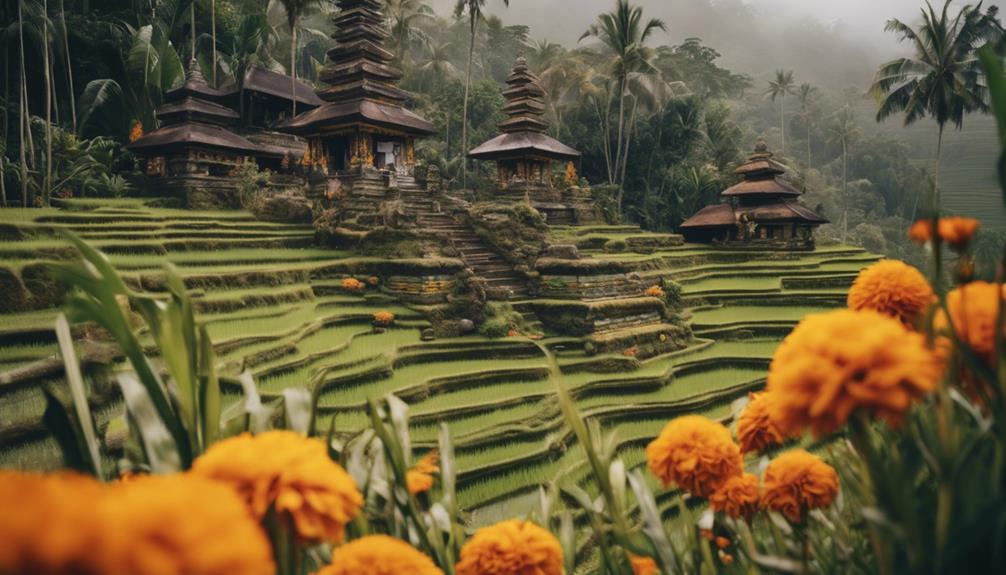
How can one begin to understand Balinese spirituality, a complex and intricate system deeply interwoven with the island's culture and daily life? You'd need to immerse yourself in the rich tapestry of Balinese Mythology, a fundamental aspect of this spiritual system. It's not merely a collection of old tales, but a living, breathing part of Balinese life. These myths shape the beliefs, rituals, and even the societal norms of the Balinese people.
Now, consider Spiritual Tourism, an innovative trend where travelers seek spiritual enlightenment and personal growth. In Bali, this takes on a unique flavor as tourists are drawn to experience the island's spiritual practices firsthand. From joining in temple ceremonies to partaking in yoga retreats, you're not just observing; you're actively participating.
However, understanding Balinese spirituality isn't just about joining in rituals or hearing legends. It's about understanding the underlying values: harmony, respect for nature, and the interconnectedness of all things. It's a mindset, a way of life, and a worldview that you absorb, bit by bit, as you engage fully in the Balinese culture. So, are you ready to participate actively?
Bali's Sacred Temples
As you explore Bali's sacred landscape, consider the significance of three prominent temples.
Uluwatu Temple's mystical presence, perched on a rugged cliff, offers a unique spiritual experience.
Journeying further, you'll encounter Besakih Temple, the spiritual epicenter, and Tanah Lot, charmingly set in the ocean, each revealing different aspects of Bali's rich spiritual heritage.
Uluwatu Temple's Mystical Presence
Perched on a dramatic cliff edge overlooking the Indian Ocean, Uluwatu Temple in Bali exudes an aura of mystical charm that you can't help but notice. This is partly due to Uluwatu Temple's architecture, which is a masterpiece of Balinese design, and the temple's historical significance, which adds an extra layer of depth to its allure.
- The temple's gates, intricately carved from local stone, are a confirmation of Balinese craftsmanship.
- Its location, high on a cliff, offers breathtaking views of the ocean and the setting sun.
- The temple's historical significance dates back to the 11th century, making it one of Bali's oldest.
- Uluwatu Temple is associated with the mythical snake goddess, adding to its mystique.
- Its tiered courtyards are a hotspot for traditional dance performances, further enhancing its cultural significance.
Besakih Temple: Spiritual Epicenter
Stepping into Besakih Temple, often referred to as Bali's 'Mother Temple,' you're immediately immersed in an atmosphere of profound spiritual significance, a palpable presence that's been cultivated over more than a thousand years of continuous worship. The Besakih Architecture, a unique fusion of Balinese and Hindu styles, is an innovation in itself.
To help envision this, let's visualize:
| External Design | Layered stone platforms rise towards the sky, mirroring Bali's sacred Mount Agung. |
| Temple Etiquette | Dress modestly in a sarong and sash, showing respect to the spiritual energy. |
| Internal Design | Intricate stone carvings and statues depict Hindu deities, symbolizing universal truths. |
| Purpose | The temple's 23 separate but related compounds serve various functions, embodying a thorough spiritual system. |
The temple's complex design reflects an advanced understanding of spirituality, making Besakih an epicenter for enlightenment seekers.
Tanah Lot's Oceanic Charm
Moving from the spiritual epicenter of Besakih, you'll find a different kind of mystic allure at Tanah Lot, Bali's oceanic temple that beautifully merges the sacred with the natural world. This striking monument isn't only a spiritual beacon but also a shining example of coastal preservation.
Here's what makes Tanah Lot's charm truly distinctive:
- The temple's awe-inspiring location on a rocky outcrop, washed by the undulating ocean waves.
- The region's rich oceanic biodiversity, visible in the surrounding coral reefs.
- An innovative system of temple conservation, ensuring its longevity amidst natural erosion.
- The sacred rituals performed at low tide, providing a unique cultural experience.
- The breathtaking sunsets that envelop the temple in a golden glow, symbolizing the harmonious coexistence of the spiritual and natural domains.
Holy Mountains in Bali
Exploring the holy mountains in Bali, you'll unearth a rich tapestry of spiritual significance interwoven with breathtaking natural beauty. You'll find that mountain pilgrimage practices are deeply rooted in the cultural and spiritual fabric of the island. A trek up these sacred peaks isn't merely a hike; it's a journey into the heart of Bali's spiritual essence.
The volcanic sanctity of these mountains is undeniable. Their violent origins embody the powerful forces of creation and destruction, a theme that resonates within Balinese spirituality. The volcanic earth is revered as a potent symbol of renewal, fostering a deep connection between the Balinese people and the natural world.
Gunung Agung, Bali's highest peak, is the most sacred. Seen as a replica of Mount Meru, the central axis of the universe in Hindu cosmology, it's a focal point for religious ceremonies. The mountain's sanctity is expressed in the Pura Besakih, a temple complex that graces its slopes.
Therefore, Bali's holy mountains offer not just awe-inspiring vistas, but also a window into the island's spiritual core, a proof of the enduring bond between man, nature, and the divine.
The Role of Sacred Rituals
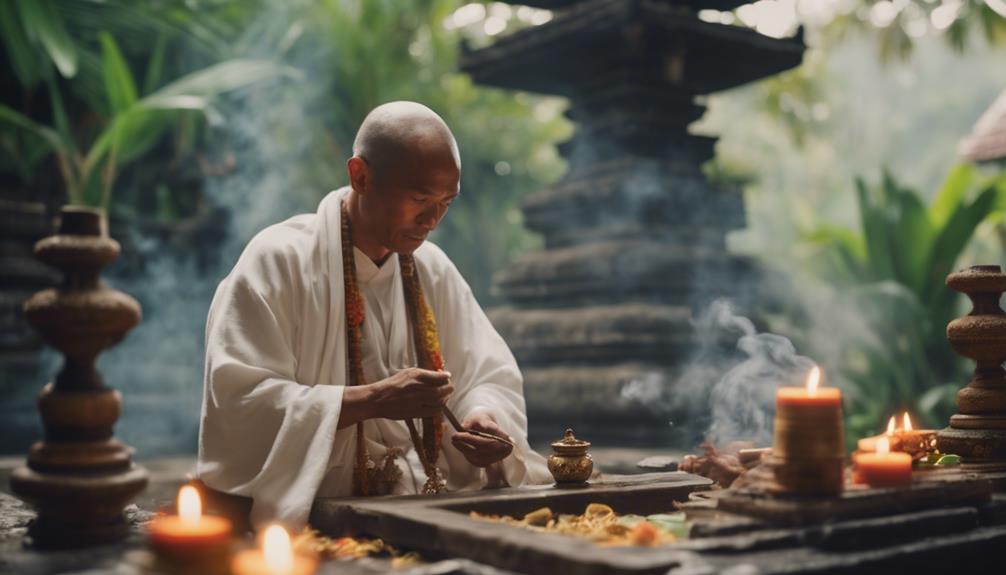
As you explore the world of Balinese spirituality, the role of sacred rituals is a compelling aspect to ponder. Understanding these rituals provides insight into the local beliefs that form the cultural backbone of Bali.
These sacred practices, steeped in centuries of tradition, play a key role in the daily life and spiritual journey of the Balinese people.
Understanding Balinese Rituals
Diving into the heart of Balinese culture, you'll find that sacred rituals play a pivotal role in shaping the island's unique social and spiritual fabric. They aren't just a spectacle for tourists but deeply influence the Balinese cuisine and dictate the etiquette expected of visitors.
Here are some key points to understand these rituals:
- The intricate offerings, known as 'Banten', are a feast of local ingredients, displaying the Balinese cuisine influence.
- Tourist etiquette is essential. Observing silence and wearing respectful attire during rituals is expected.
- Each ritual has a precise timing, aligned with the Balinese calendar.
- Rituals aren't simply religious. They're social events binding the community together.
- Rituals also mark rites of passage, celebrating life's key stages.
Rituals and Local Beliefs
In the domain of Balinese culture, you'll find that sacred rituals not only permeate the everyday lives of locals but also serve as a critical foundation for their beliefs.
Sacred Cuisine, for instance, is more than just food. It's an essential part of rituals, symbolizing a bond between the divine and humans.
You'll also discover a rich tapestry of Balinese Mythology woven into these ceremonies, reflecting a unique worldview.
For the Balinese, these rituals aren't mere traditions; they're living, breathing embodiments of their faith, shaping their interactions, decisions, and perspectives.
Unraveling these rituals, you'll encounter an intriguing blend of tradition and innovation, a proof of the dynamic and resilient spirit of Bali.
Sacred Art in Balinese Culture
You'll find that sacred art permeates every facet of Balinese culture, serving not only as a form of aesthetic expression but also as a profound spiritual conduit. This form of art, deeply rooted in tradition and spirituality, is an integral part of Balinese daily life and ceremonies.
One can't overlook the significance of Sacred Tattoos and Balinese Iconography. These art forms, steeped in religious and cultural symbolism, serve as a bridge between the physical and spiritual world, and are a demonstration of the Balinese people's deep-rooted spirituality.
Here are some fascinating aspects of sacred Balinese art to consider:
- Sacred Tattoos: Intricate designs that symbolize protection and spiritual guidance.
- Balinese Iconography: Depictions of deities and mythological creatures that hold religious significance.
- Traditional Batik: A textile art form filled with symbolic patterns and colors.
- Stone Carvings: Sculptures that adorn temples and houses, embodying local myths and beliefs.
- Dance and Drama: Artistic expressions that narrate ancient epics and spiritual teachings.
Importance of Ancestral Worship
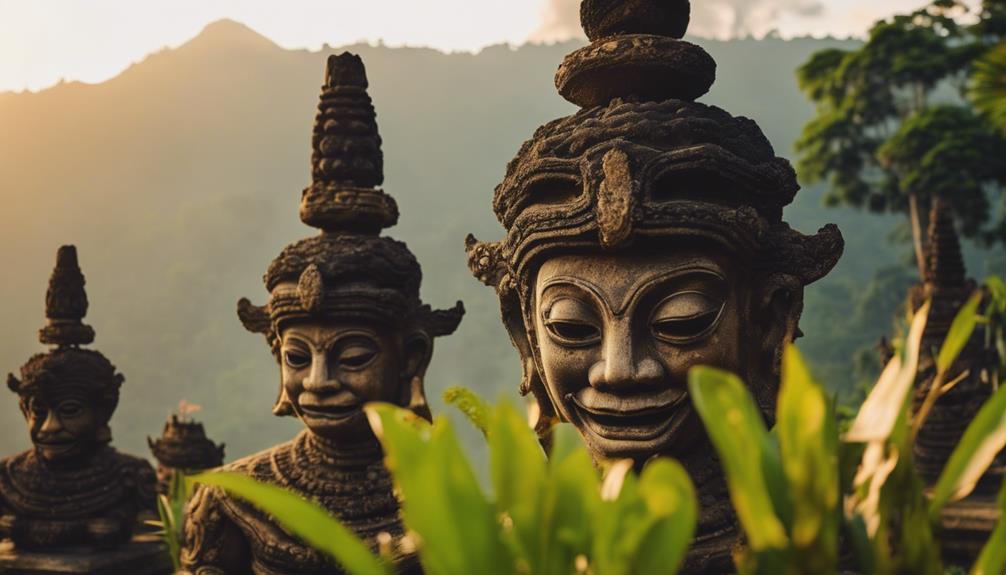
Shifting focus from sacred art, let's explore the importance of ancestral worship in Balinese culture. Ancestral worship is integral to the Balinese way of life. It's more than just a tradition; it's a form of respect and remembrance, a connection with the past to inform the present and future. At the heart of this practice are the Ancestral Shrines, an architectural wonder that facilitates Spirit Communication.
Ancestral Shrines aren't mere decorative elements; they serve a crucial function in bridging the gap between the physical and spiritual planes. They're spaces for communion, where offerings to ancestors are placed, prayers are uttered, and wisdom from the past is sought. Spirit Communication, through these shrines, helps Balinese people maintain a harmonious relationship with their ancestors.
Ancestral worship, hence, becomes a platform for dialogue between the present and the past. It's an innovative system that preserves wisdom while allowing for adaptation to the currents of modern life. Ancestral worship in Bali is a dynamic practice, where reverence for tradition melds with the needs of the present, shaping a society that's deeply connected to its roots yet open to change.
Bali's Sacred Festivals and Ceremonies
Delving into Bali's sacred festivals and ceremonies, we find a vibrant tapestry of rituals that enrich the island's cultural and spiritual landscape. These events not only display the island's rich history and tradition, but they also ignite innovation, creating a dynamic fusion of past and present.
Here are some intriguing aspects that make these ceremonies unique:
- Festival Food: The food prepared during these events isn't just sustenance, but also an offering to the divine. Each dish is meticulously crafted, embodying the island's culinary heritage.
- Traditional Costumes: The Balinese don traditional costumes during these ceremonies, each outfit telling a unique story and reflecting the island's vibrant culture.
- Sacred Rituals: Each festival is marked by a series of sacred rituals, performed to honor deities and ancestors, invigorating the spiritual essence of the island.
- Community Involvement: These events are community-centered, fostering a sense of unity and cohesion among the islanders.
- Innovation: While these festivals and ceremonies are steeped in tradition, they continuously evolve, reflecting Bali's innovative spirit.
Though these elements, Bali's sacred festivals and ceremonies offer a profound glimpse into the island's cultural and spiritual panorama.
The Sacredness of Balinese Dance
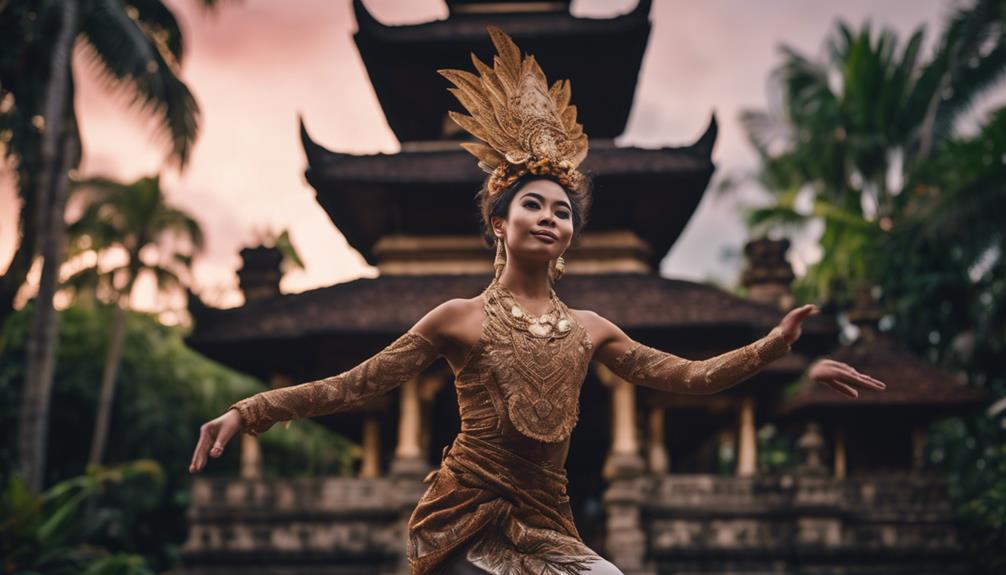
You'll find that Balinese dance is steeped in symbolism, each movement expressing deep spiritual meanings. The act of dancing fosters a profound spiritual connection, bridging the gap between the human and the divine.
Additionally, dance is an integral part of rituals in Bali, underscoring its sacredness in the Balinese culture.
Symbolism in Balinese Dance
Bali's traditional dance, brimming with sacred symbolism, invites a deeper understanding of the island's spiritual culture. Dance costumes and dance training are integral components of this ancient art form, each imbued with deep symbolism and significance.
To immerse oneself in the rich symbolism of Balinese dance, consider these elements:
- The intricate costume design, reflecting divine beauty.
- The rigorous training dancers undergo, symbolizing commitment and discipline.
- The expressive hand gestures, or 'mudras', signifying a multitude of narratives and emotions.
- The rhythmic footwork, embodying the balance between human beings and the natural world.
- The vibrant mask used in some performances, representing different characters and deities.
Each component isn't just a spectacle for your eyes, but an invitation to understand a culture that values sacredness, even in art.
Spiritual Connection Through Dance
In exploring the sacredness of Balinese dance, you'll find it's not just an art form, but a spiritual conduit that connects the dancers, audience, and the divine.
It's a vibrant display of cultural preservation, where dance costumes play a significant role, not just aesthetically, but in enhancing the spiritual connection. These costumes, resplendent with intricate designs and traditional symbols, are more than mere adornments.
They serve as a bridge between the material and spiritual worlds, anchoring the dancers in their cultural heritage while elevating the performance to a divine level. Ultimately, the sacredness of Balinese dance lies in this blend of artistry and spirituality, where every movement becomes a sacred communication, fostering a profound connection that transcends the physical cosmos.
Ritualistic Aspect of Dance
Delving into the ritualistic aspect of Balinese dance, it's clear that each step and gesture holds deep spiritual significance, acting as a conduit for the dancers to connect with and honor the divine. You'll notice that:
- Dance costumes are meticulously designed, each detail imbued with symbolic meaning.
- Traditional music sets the atmosphere, enhancing the spiritual connection.
- The dancers' precise movements reflect the intricate narratives of Balinese mythology.
- Every performance is a form of prayer, offering gratitude to the gods.
- The communal participation in these dances strengthens the societal fabric.
The sacredness of Balinese dance isn't simply a cultural affirmation. It's a living, breathing confirmation to the island's deep spirituality, underscoring the symbiotic relationship between the human and divine, tradition and innovation.
Holy Waters: Bali's Sacred Springs
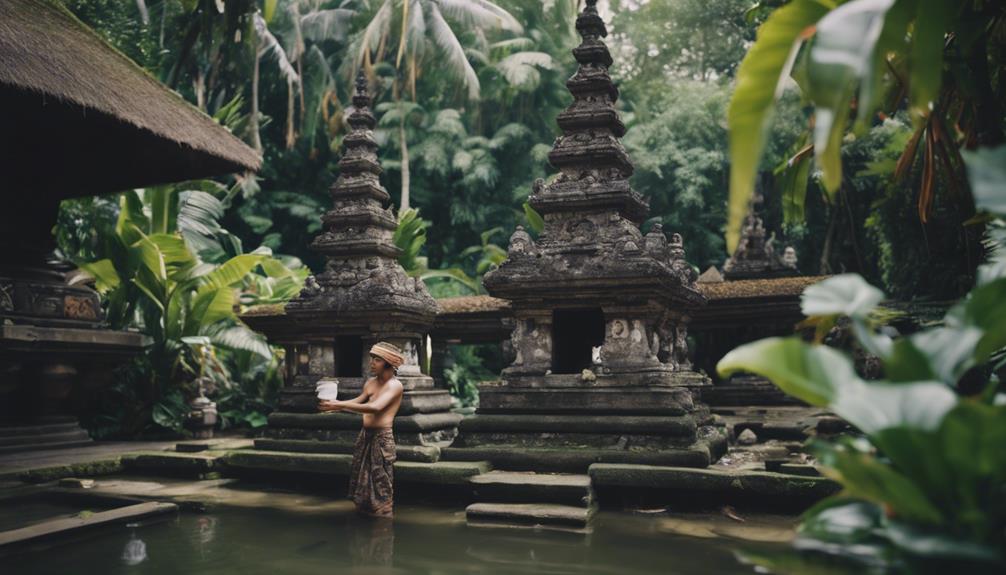
While exploring the spiritual heart of Bali, you'll encounter its sacred springs, revered as holy waters that hold an essential role in the island's religious rituals and ceremonies. Spring Purification, a process of cleansing oneself physically and spiritually, is a common practice. It's believed these waters, imbued with the divine, have the power to heal and renew.
These springs often serve as the source of Water Offerings, an integral part of the Balinese ritualistic culture. Locals fill vessels with this sanctified water, presenting them at altars and temples as a symbol of respect and devotion. It's a tangible representation of their connection to the divine, a critical element in their spiritual lives.
However, there's more to these springs than their spiritual importance. From a hydrological perspective, they're a natural marvel, a demonstration of Bali's rich biodiversity and vibrant ecosystems. Scientifically, they're groundwater outlets, where water from rain or other sources seeps into the ground and resurfaces, purified naturally.
In Bali's evolving spiritual landscape, these springs stand as a proof to the island's enduring reverence for nature, exemplifying the harmonious blend of tradition and innovation that characterizes their religious practices.
Sacred Balinese Symbols and Their Meanings
Moving beyond the holy waters, you'll encounter a myriad of sacred symbols in Balinese culture, each bearing its own profound meaning and significance. Often, these symbols are embedded in art, architecture, and even sacred tattoos, making them integral to the Balinese way of life. They're not just mere decorations, but they're imbued with deep-rooted beliefs and stories from Balinese mythology.
To give you a more detailed perspective, let's explore into some of these symbols:
- Swastika: In Bali, it's a symbol of balance and harmony, not to be confused with its misappropriation in recent history.
- Padma: The lotus flower signifies purity and spiritual enlightenment.
- Trisula: This three-pronged spear represents the three fundamental aspects of life: creation, preservation, and destruction.
- Cakra: Depicting a wheel, it's a symbol of the endless cycle of birth, life, and death.
- Lingga-Yoni: It embodies the concept of duality and unity, often interpreted as male and female elements.
These symbols, you'll find, are deeply interwoven in Balinese culture and are physical representations of philosophical concepts. So, as you navigate Bali, these symbols serve as silent guides, helping you to understand the island's spiritual landscape better.
Animals and Their Sacred Roles

In the rich tapestry of Balinese culture, animals play a significant role, each revered for its unique spiritual significance and sacred symbolism. They're not just part of the Sacred Flora and fauna, they're also seen as Animal Totems, representing values and teachings that are integral to the Balinese way of life.
Here's a table that captures the essence of this relationship:
| Animal | Spiritual Significance | Role in Balinese Culture |
|---|---|---|
| Monkey | Knowledge and Learning | Symbolizes wisdom, present in many temples |
| Cow | Prosperity and Fertility | Represents abundance, used in religious rituals |
| Bird | Freedom and Enlightenment | Symbolizes transcendence, found in traditional art |
| Snake | Transformation and Renewal | Represents change, used in healing rituals |
Each animal, with its assigned symbolism, contributes to the layered richness of Balinese culture, ensuring its preservation and continuity. As you explore further into this fascinating culture, you'll find that each creature is a crucial thread in the intricate weave that makes up the sacred animal tapestry of Bali. Paying attention to these nuances will provide a richer understanding of the spiritual landscape of this unique culture.
Sacred Spaces: The Balinese House Compound
Stepping into a traditional Balinese house compound, you'll quickly notice it's not just a place for living, but a sacred space meticulously designed to mirror the cosmos and the Balinese worldview. The architectural significance of this space is undeniable, with every corner richly embedded with cultural influences.
Explore further, and you'll discover:
- Each compound's layout replicates the universe's structure, with the 'head' towards Mount Agung, and the 'feet' towards the sea.
- The Balinese belief in 'Tri Hita Karana' (a harmonious relationship between humans, God, and environment) is reflected in the architecture.
- The compound is divided into three areas symbolizing the Hindu trinity (Brahma, Shiva, Vishnu).
- Walls and gates are meticulously adorned, showcasing the Balinese affinity for intricate design.
- Every element, be it the placement of buildings or choice of materials, has a symbolic meaning.
Innovative, isn't it? You're not just viewing an abode; you're witnessing an ancient philosophy materialized through architecture. It's a profound indication of how deep-rooted traditions and beliefs can influence design processes in a profound way, creating spaces that are more than mere shelters, but sacred habitats that align with the cosmos.

